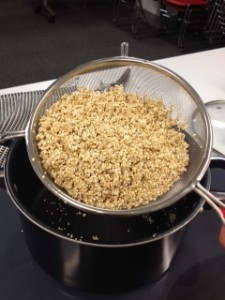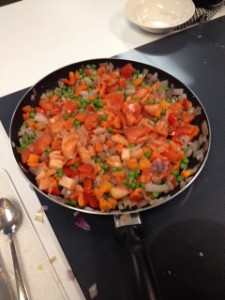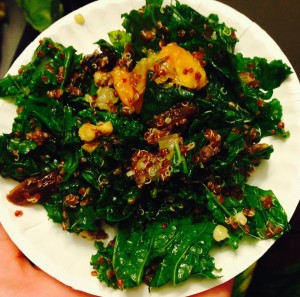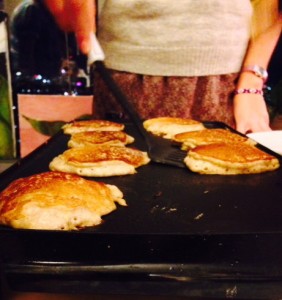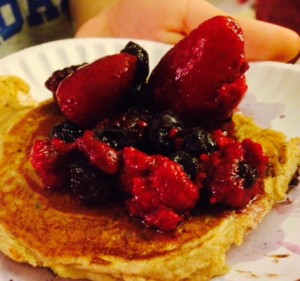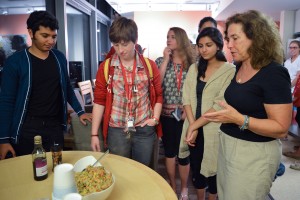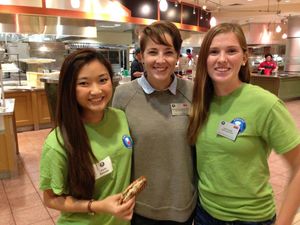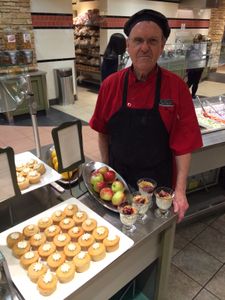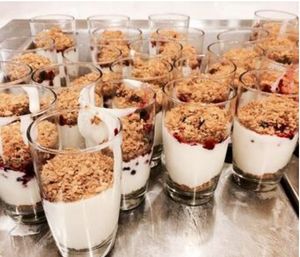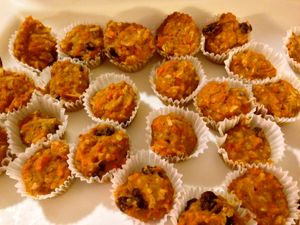By Caroline Booth, Graduate Nutrition Student
Last night’s Test Kitchen was a wonder. Karen Jacobs generously held her open ours in spite of BU’s closure for an amazing night of bones and food. Dr. Jonathan Bethard, a BU professor in the Department of Anatomy and Neurobiology gave us an enthralling talk about his career and current endeavors in the world of biological anthropology (he’s doing research near Dracula’s home in Romania). We didn’t even start cooking until half way through the night because we were too busy asking questions and examining real human bones from a Romanian medieval church’s excavation site!
Dr. Bethard explained how a skeleton’s teeth reveal many secrets about that person’s diet and where he or she grew up. Even more telling are the tartar pieces that can be found between the teeth and, in his skeleton’s case, remained intact from sometime between the 14th and 16th centuries—talk about needing a check up with the dentist. However, in today’s world of forensic anthropology it becomes much more difficult to identify where a person lived because people consume foods from all over the world. For instance, our honey ginger tofu and vegetable stir-fry was comprised of ingredients that came from all over, not just the Boston area.
When we got around to making this dish, it was ready in a breeze. The colors of the carrots and broccoli were so vibrant and inviting, along with the honey ginger sauce that smelled incredibly appetizing. All of us were overjoyed to warm up with such a comforting meal in the midst of a blizzard outside (that we soon had to combat on our journeys home). At the end of the night we had no leftovers to spare, but had many stories to tell. If you’re looking for a hearty pick-me-up in this cold, snowy winter I would suggest giving this recipe a chance. Share it with good company, and you’ll feel instantly satisfied.

Sargent Choice
Honey Ginger Tofu and Veggie Stir Fry
Recipe modified from Pinch of Yum
Makes 4 servings
Ingredients for the Stir Fry:
1 cup uncooked brown rice
1 tablespoon vegetable oil or canola oil
14 ounces extra firm tofu
2 cups chopped broccoli florets
2 cups shredded carrots
3 green onions, minced
Ingredients for the Stir Fry Sauce:
3 cloves garlic
2 tablespoons chopped peeled fresh ginger
2 tablespoons honey
⅓ cup low sodium soy sauce
¼ cup water
3 tablespoons rice wine vinegar
3 tablespoons vegetable oil or canola oil
Directions
Rice: Cook the rice according to package directions.
Sauce: Puree all of the sauce ingredients together in a food processor until smooth. Set aside. Tofu: Cut the tofu into ½-inch slices and press with a paper towel to remove excess moisture. Wait a few moments and press again. Cut the tofu slices into small cubes, approximately ½-inch. Heat the oil in a large nonstick skillet over medium heat. When the oil is shiny, add the tofu and about ¼ cup of the stir fry sauce (CAREFUL – the oil and sauce will spatter a bit). Pan-fry the tofu until golden brown. Remove the tofu from the pan and drain on paper towel lined plate.
Veggies: Return the pan to the heat and add the broccoli florets with ¼ cup stir fry sauce. When the broccoli is bright green and almost tender crisp, add the carrots and cook for an addition minute or two. Return the tofu to the pan. Arrange the veggies and tofu over the cooked rice, and cover with more sauce to taste. Sprinkle with the green onions.
Nutrition Facts
(⅓ cup rice with 1 cup tofu and veggies in sauce)
| Calories | 330 |
| Fat | 13 g |
| Saturated Fat | 2 g |
| Protein | 11 g |
| Carbohydrate | 40 g |
| Fiber | 5 g |
| Sodium | 610 mg |
